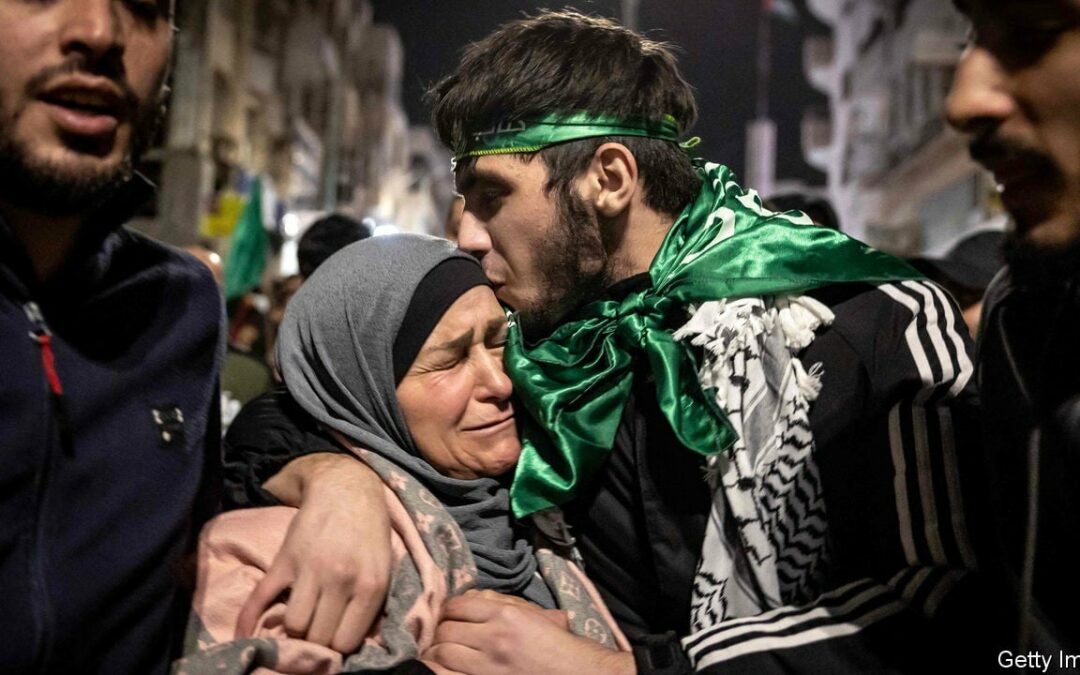Hamas hopes to swap more for Israeli hostages
Your browser does not support this video. Released Palestinian prisoners are greeted in the West Bank Image: Getty Images
Over the past four days, as part of a truce, Israel has released 117 Palestinian prisoners in exchange for 40 Israeli and 18 foreign hostages; those figures are due to reach 150 prisoners and 50 Israeli hostages respectively by November 28th, the date when the pause in fighting was originally set to end. On November 27th Israel and Hamas agreed to a two-day extension, with more hostages and prisoners set to be released. Exchanging Israeli captives for Palestinian prisoners has long been a practice in the Israeli-Arab conflict. Whereas Israel refers to those it releases as terrorists, Palestinians call them prisoners of war. Who are the Palestinians in Israeli prisons?
Days before the truce began Israel’s government published a list of 300 Palestinians who could be released as part of the exchange with Hamas. Almost all are from the West Bank and East Jerusalem; just five are registered as residents of Gaza. Around 90% are teenage boys between 16 and 18 years old, and the remainder are mostly adult women. Only 67 have been sentenced; the rest are awaiting trial. More than 200 were due to be—or have already been—prosecuted in military courts. Palestinian civilians, including those under 18, can be prosecuted in such courts. Human-rights groups have raised concerns about very high conviction rates, the lack of legal support for Palestinians and poor conditions in Israeli prisons.
Israel says that some of the 300 slated for release are affiliated with Palestinian militant groups, including Hamas and Palestinian Islamic Jihad, but close to half have no political affiliation. They are accused of a variety of crimes, ranging from throwing stones to threatening “regional security”. None has been convicted of murder; in previous prisoner swaps, some of those freed had been found guilty of that crime.
Detainees eligible for release as part of a hostage exchange
Source: Israeli Ministry of Justice
The 150 prisoners who should be released by the morning of November 28th are a small proportion of the Palestinians held in Israeli prisons. Addameer, a Palestinian NGO, estimates that before Hamas’s attack on Israel 5,200 Palestinians were in Israeli jails, including more than 1,200 in “administrative detention”, meaning they were held without charge. That number has risen dramatically since October 7th. Adameer reckons that on November 6th Israeli authorities held 7,000 Palestinians in detention, including 2,070 in administrative detention. That is the highest figure in recent decades. It is not unusual for the numbers to surge during intensified conflict. In 2014—during the last major war between Israel and Hamas—the number of Palestinian administrative detainees rose from 175 in January to 463 in December, according to B’Tselem, an Israeli human-rights organisation. A special rapporteur to the UN says that, in all, Israel has detained over 800,000 Palestinians in the occupied territories, including tens of thousands of children aged between 12 and 17, since 1967.
Some past exchanges have been much larger than the latest. In 2011 Israel freed 1,027 Palestinians in exchange for Gilad Shalit, a soldier captured by Hamas in 2006. In 1983 it swapped about 4,500 Palestinian prisoners for six soldiers held by the Palestine Liberation Organisation. Many Palestinians have relatives in jail—and feel fiercely for the fate of prisoners. Hamas is well aware of this, and will hope to benefit from this exchange, particularly in the West Bank, where Fatah, its nationalist rival, is widely loathed. Indeed after the first batch of hostages was released, some were greeted in the West Bank by crowds waving the flag of Hamas. ■











